| Srl | Item |
| 1 |
ID:
122413
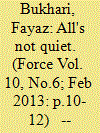

|
|
|
| 2 |
ID:
160661
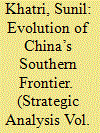

|
|
|
|
|
| Summary/Abstract |
The People’s Republic of China (PRC)’s case on the Sino–Indian boundary question has not received the sort of attention it deserves with the result very little is known about it. While India appears to have inherited its northern frontier from the British with some ambiguities, Manchu China’s territorial bequest to the Republic of China (RoC), in comparison, is more straightforward. Both foreign and Indian writers have subjected the Indian case to rigorous scrutiny. However, the PRC’s case has, thus far, escaped similar scrutiny. Consequently, the burden of proof appears to have been shared asymmetrically between the Indians and the Chinese. An attempt has been made to trace the evolution of China’s southern frontier and in so doing; the RoC/PRC’s cartographical encroachments on Indian Territory in the two sectors between 1922 and 1960 will be examined. The unilaterally declared Sino–Indian boundary alignment emanating from these cartographical encroachments finds no support in history, for nothing happened in those 38 years or before or after, to give rise to such a claim. There is neither any evidence to suggest that the cartographically encroached territories had ever been a part of China at any time in the past, nor was any proof forthcoming to show that jurisdiction had been exercised over them before October 1949, i.e. prior to the PRC’s coming into being. Chinese cartographical encroachments can be divided broadly into three phases. First, up to 1921, when neither official nor privately published Manchu/RoC maps depicted Indian Territory as Manchu/Chinese. Second, between 1922 and 1946, when some privately published maps depicted Indian territory as Chinese, but the official ones did not. Third, from 1947 onwards, the Sino–Indian boundary alignment shown in official RoC/PRC maps is the same as that in the privately published Chinese maps of the second phase.
|
|
|
|
|
|
|
|
|
|
|
|
|
|
|
|
| 3 |
ID:
130603
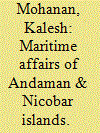

|
|
|
|
|
| Publication |
2014.
|
| Summary/Abstract |
India has a vast coast line and has a rich maritime history which dates back to pre-Harappa period. By virtue of lndia's geographical location on the global map and specifically its strategic location in the Indian Ocean, makes India a subcontinent in itself. The Andaman & Nicobar Islands are a group of islands located east of India in the Bay of Bengal, and possess a wide area of thick dense forest and white beaches. Although little is known about the islands during the ancient period, but there is evidence to suggest that these islands have been inhabited for more than three thousand years.
|
|
|
|
|
|
|
|
|
|
|
|
|
|
|
|
| 4 |
ID:
104701


|
|
|
| 5 |
ID:
115955
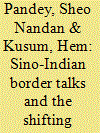

|
|
|
| 6 |
ID:
131025
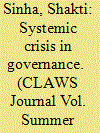

|
|
|
|
|
| Publication |
2014.
|
| Summary/Abstract |
Till a few years ago, the Indian elite had convinced itself that India was already seated at the high table of the international order, that there was something natural and given about lndia's rise. This acute sense of triumphalism was unmistakeable. India in 2007 had reason to be con?dent. It was growing fast and furious, had lifted hundreds of millions above the poverty line, and was being courted by leading economies and large investors and the India story seemed a perpetual best-seller. The 2008 trans-Atlantic monetary crisis saw the rich countries go into economic decline whilst India recovered quickly and grew faster than before. The clear conviction was that India had decoupled itself from its economic partners in Europe and North America, and was itself an engine of global economic growth. The fact that China also grew faster than before convinced many that the West was in terminal decline and the future of Asian dominance had arrived. The hubris was not long in coming. Indian policy-makers did seem to have not taken notice of the fact that the high growth of Gross Domestic Product (GDP) post-2003 had resulted Mr Shakti Sinha is former Principal Secretary (Power 8: Industry), Government of National Capital Territory of Delhi and former Chief Secretary, Andaman 8: Nicobar Administration.
|
|
|
|
|
|
|
|
|
|
|
|
|
|
|
|